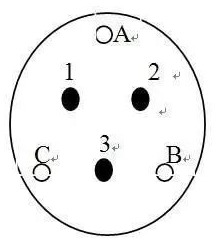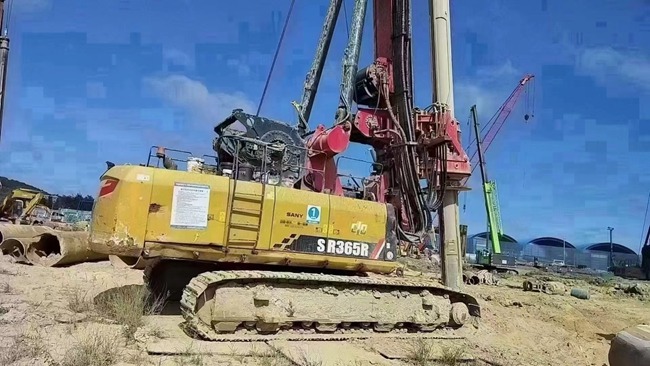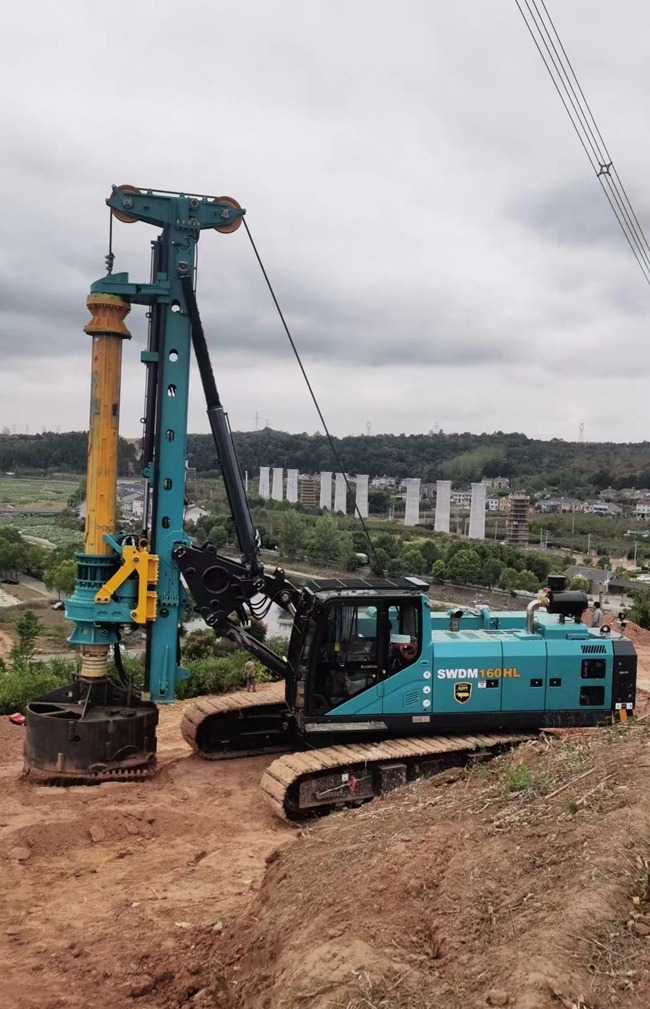During the construction of pile foundations, due to geographical environment, mechanical equipment, and human factors, it is inevitable that some defective piles will appear during the construction process. Once defective pile foundations appear, there are different treatment methods for different degrees of defects, but low-cost and high-efficiency methods are what people have been pursuing.
Pile Foundation Defect Types:
Defects at the top of the pile foundation, defects at the middle of the pile foundation, and defects at the bottom of the pile foundation
1. Defects on top of pile foundation
Since mud precipitates during the underwater concrete pouring process, it is difficult to accurately estimate the thickness of the laitance. When the concrete on the top of the pile is not overfilled, mud inclusions in the concrete will inevitably occur, affecting the quality of the concrete. Secondly, after the concrete pouring is completed, the demolition When pulling out the embedded steel casing, excessive force or uneven left and right force will disturb the concrete on top of the pile and affect the quality of the concrete. Finally, during the process of cutting out the concrete at the pile head, due to the excessive power of the pneumatic pick, the concrete around the acoustic tube was disturbed to varying degrees, which also had a certain impact on the quality of the concrete.
2. Defects in the middle of the pile foundation
First of all, due to poor geological conditions, local collapse of holes occurred during the concrete pouring process, which partially prevented the concrete from grouting, resulting in local defects. Secondly, excessive force was used during the removal of the conduit, which disturbed the continuity of the concrete and affected the quality of the concrete. Finally, the air tightness of the conduit is poor. Since the conduit enters the mud during underwater concrete pouring, the pressure difference between the inside and outside of the conduit is destroyed. In some cases, it affects the continuity of concrete quality. In severe cases, it hinders concrete cutting and prevents normal grouting, resulting in broken piles.
3. Defects at the bottom of the pile foundation
Before the concrete pouring of the pile foundation begins, the defects of sedimentation at the bottom of the pile will be caused due to unclean slag removal, or the first pouring of concrete will not seal well, resulting in defects such as the addition of mud or defects in the concrete at the bottom of the pile, and the concrete at the bottom of the pile will not be dense when leaving the mat. Core grouting processing method.
Treatment Methods for Pile Foundation Defects
1. Treatment of defects on top of pile foundation
According to the test results, if there are defects at the top of the pile foundation, we can continue to chip away at the concrete at the pile head until the quality of the concrete is intact. However, during the process of cutting down the concrete, attention should be paid to observation, and the abnormal locations of defects in the concrete should be discovered in time, corresponding to the experimental testing data, and finally the piles should be connected with the concrete of the same grade as the pile foundation. Be careful to protect the pile foundation steel bars during the process of cutting down the concrete to prevent damage.
2. Treatment of defects in the middle part of pile foundation
It is difficult to uniformly measure the treatment of such pile foundation defects. Small defects can be treated with grouting. For large defects, generally more than two meters, it is difficult to ensure quality through grouting. The pile is usually scrapped and re-punched at the original location. , installing steel cages, and pouring concrete.
3. Treatment of defects at the bottom of the pile foundation
If there is a defect at the bottom of the pile foundation, according to the stress properties of the pile foundation, a simplified stress calculation can be performed first, and then it is determined whether it needs to be treated. If the pile foundation is a friction-bearing pile, the length of the defect position does not affect the overall load force. That is to say, in the part of the pile length excluding the defect, the friction force can already meet the load requirements, and no further treatment is needed. Otherwise; must be processed. If the pile foundation is a rock-embedded pile and the bottom is defective, it must be treated. Pile bottom grouting is a feasible treatment method.
(1) Preparation for pile bottom grouting
Reasonable grouting design is the prerequisite for grouting. To make the pile bottom grouting construction reasonable and effective, it is necessary to conduct a detailed investigation and analysis of the pile foundation’s rock formation geology, groundwater conditions, defect levels, and surrounding environment, and calculate the amount of cement slurry. , scientifically prepare the grouting slurry using one-grade cement higher than the pile concrete, and determine the grouting pressure and other parameters.
(2) Drilling
Drill 3 grouting holes in the pile body of the defective pile. Verticality must be ensured during the drilling process to ensure that the drilled holes are parallel to the axis of the pile foundation to prevent the drilled holes from being deflected, touching the pile foundation steel bars, or penetrating the pile foundation. The hole depth is 1 meter deeper than the pile length.
(3) Pressure water test
The pressure water test not only plays the role of clearing the grouting pipeline but also adjusts the operating experience parameters related to grouting according to the results of the pressure water test. The pressure water test can also remove sediment and mud at the bottom of the pile. As shown in the picture, inject clean high-pressure water into hole No. 1, close hole No. 2, and open pipe No. 3 until the water turns out become clear. Then open hole No. 2, close hole No. 3, and repeat the above operations. Then inject the high-pressure water head into hole No. 2 and hole No. 3 respectively, and repeat the above operation.

(4) Grouting
After the hole is cleaned, prepare the slurry according to the slurry mix ratio. In the process of preparing the slurry, carefully weigh the amount of water and additional dosage, stir evenly, and prepare the test piece.
When the various indicators of the slurry meet the requirements, inject the cement slurry into hole No. 1, open holes No. 2 and No. 3 at the same time, pressurize, and start grouting. Through grouting, all the clean water in other pipes will be replaced until the water in the pipe is filled. Turn out the slurry and drain out 100L of the slurry, then inject cement into hole No. 2. At the same time, open holes No. 1 and 3 first, and wait until a uniform slurry is discharged, and the composition is basically the same as the configured slurry, and finally inject the cement slurry. For hole No. 3, repeat the above operation.
Connect the grouting interface to hole No. 1, close holes No. 2 and No. 3 at the same time, and increase the grouting pressure to 50Pa for 5 minutes. Then connect the grouting interface to hole No. 2, and close holes No. 3 and 1 at the same time. When the grouting pressure reaches 50Pa, continue for 5 minutes. Finally, connect the grouting interface to hole No. 3, and close hole No. 2 at the same time. and hole No. 1, when the grouting pressure reaches 50Pa, continue for another 5 minutes. Close all valves, dismantle the grouting equipment, and clean it.
(5) Control grouting parameters to improve grouting effect
During the grouting process, the grouting pressure, grout consistency, injection rate, and grouting volume all change during the grouting process, so reasonable control of their changes is very important to improve the grouting effect.
The grouting pressure changes from low to high as the grouting amount increases. If the grouting pressure suddenly drops sharply during the grouting process, it indicates that there is local grout leakage or air leakage. Check the grouting pipeline in time, and it may be possible. The grouting pipe is damaged, or cracks may appear around the pile foundation. Admixtures should be added to the slurry in time, grouting should be done intermittently, and grouting should be done multiple times to ensure quality.
(6) Principle of pile foundation grouting to improve bearing capacity:
Improve the original geological conditions and increase the bearing capacity. During the hole-forming process of the cast-in-place pile, the machinery has a certain disturbance effect on the surrounding strata of the pile, weakening the bearing capacity of the entire pile foundation. During the pouring process of concrete, the friction force of the mud skin on the hole wall of the entire pile foundation is weakened, which also affects the bearing capacity of the entire pile foundation. Pile bottom grouting makes the pile end stress layer form a combination of grout and soil within a certain range through penetration, splitting, and squeezing, thereby improving the physical properties of the stress-bearing structure and repairing and improving the strength of the stress-bearing soil. strength.
Because the holes at the bottom of the cast-in-place pile are not cleaned before pouring concrete, the existence of sediment at the bottom of the pile directly affects and seriously reduces the bearing capacity of the pile bottom. Through grouting, the sediment at the bottom of the pile can be replaced, compacted, and consolidated to improve and eliminate the pile. The bottom sediment exerts a bad influence on the bearing capacity.
Dramatically increase the pile foundation friction resistance. Under the action of high-pressure grouting, the slurry can move upward from the pile end along the pile side through penetration, splitting, filling, squeezing, and cementation. The mud skin and protective wall around the pile are replaced and the gaps are filled, forming a vein-like stone body around the pile, which greatly increases the pile foundation side friction.
Improve the stress state and load transfer performance. Pile foundation grouting forms a pile end enlargement through penetration, splitting, squeezing, and cementation, which increases the pile end stress area, and grouting strengthens the bearing layer of the pile foundation. , improving the stress state. After grouting at the bottom of the pile, the friction resistance on the side of the pile foundation increases before the pile end bearing capacity increases. Among friction piles, the effect is best.
Reinforcement benefit analysis: By comparing the ultrasonic testing data before and after the grouting treatment of defective piles, it was found that the concrete at the bottom of the pile has been significantly improved and the benefits are considerable.
Thanks




